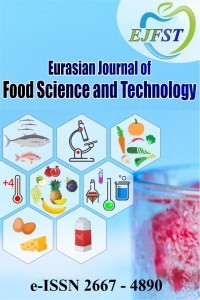MATHEMATICAL MODELING OF APRICOT DRYING
MATHEMATICAL MODELING OF APRICOT DRYING
apricot, drying microwave, mathematical modeling,
___
- Huang, W., Bi, X., Zhang, X., Liao, X., Hu, X., Wu, J. (2013). Comparative study of enzymes, phenolics, carotenoids and color of apricot nectars treated by high hydrostatic pressure and high temperature short time. Innovative Food Science and Emerging Technologies. 18, 74–82.
- Lewicki, P.P. (2006). Design of hot air drying for beter foods. Trends in Food Science & Technology. 17, 153–163.
- Marquez, C.A., Michelis, A.D., Giner, S.A. (2006). Drying kinetics of rose hip fruits (Rosa eglanteria L.). Journal of Food Engineering. 77, 566-574.
- Orsat, V., Yang, W., Changrue, V., Raghavan, G.S.V. (2007). Microwave-assisted drying of Biomaterials. Trans IChemE, Part C, Food and Bioproducts Processing. 85, 255–263.
- Sass-Kiss, A., Kiss, J., Milotay, P., Kerek, M.M., Toth-Markus, M. (2005). Differences in anthocyanin and carotenoid content of fruits and vegetables. Food Research International. 38, 1023–1029. Toğrul, İ.T., Pehlivan, D. (2003). Modelling of drying kinetics of single apricot. Journal of Food Engineering. 58, 23–32.
- Yayın Aralığı: Yılda 2 Sayı
- Başlangıç: 2017
- Yayıncı: İlknur BAĞDATLI
Physicochemical and Nutritional Properties of Bitter Melon at Four Maturation Stages
Yasin OZDEMIR, Aysun OZTURK, Senem TUFEKCI, Ozge KESKINEL, Rena İ. KOSTI
An Overview of Nano-Scale Food Emulsions: A Mini Review
Şelale YALÇINÖZ, Emine ERÇELEBİ
Temperature dependency of sweet cherry concentrate colour: a kinetic study
Şelale YALÇINÖZ, Emine ERÇELEBİ
Merve Gozde COSKUN, Perihan YOLCI OMEROGLU, Omer Utku COPUR
Effects of Cultivar, Maturity Index and Growing Region on Fatty Acid Composition of Olive Oils
Songül KESEN, Asghar AMANPOUR, A. Salih SONMEZDAG, Hasim KELEBEK, Serkan SELLİ
Characterization of fatty acids composition in Iranian Phishomi extra-virgin olive oil
Asghar AMANPOUR, Songul KESEN, Hasim KELEBEK, Serkan SELLI
Gülşah KANBUR, Yusuf CUFADAR, Rabia GÖÇMEN, Ahmet ÜNVER
MATHEMATICAL MODELING OF APRICOT DRYING
